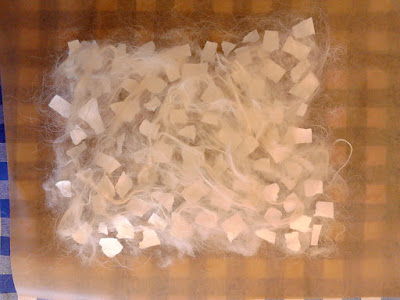In June I had taken a Zoom workshop, with artist Tunde Toth, on silk fibre papermaking (which I blogged about here) and immediately knew I planned to make more of the paper for my printmaking when taking up studio residency at Signal Arts Centre come autumn. Well, that time came fast enough and I spent the first week (plus a bit of the second week) focussed on making silk fibre paper. One of the first things for me to do, then, was set up a work station: spreading a clean table cloth over the table, having water bottle spritzer filled, iron to hand, scissors, ruler, bag of silk fibre, parchment paper roll, small dry brushes, pigments, and strips of Fabriano paper that I planned to use as inclusions.
Musings about art, writing, music, travel and food (life, the universe & everything...) by Lorraine Whelan
Wednesday, 28 October 2020
Signal studio residency: making silk fibre paper
Wednesday, 21 October 2020
binding the chapbook
In my previous blog, here, I discussed the preparation for binding and gave links to all my blog posts relating to this chapbook. With everything ready, the next step is simply to bind the books!
In creating a traditional poetry chapbook (less than 40 pages) I also decided to bind the book with thread (as opposed to stapling) and use a very simple saddle stitch with three holes in the spine. I have made a diagram of the thread journey below, where A, B and C represent the spine holes. The solid lines with arrows represent the direction of the thread on the exterior, and the broken lines with arrows represent the direction of the thread on the interior. Just as a reminder, the pages should be placed inside each other, as per the right side of my diagram.
On my books I decided to leave these threads at about 6 cm as a design feature, first tying knots in the thread ends to prevent separation of the strands.
Wednesday, 14 October 2020
Preparing to bind the chapbook
By request, my husband (artist James Hayes) made me a beautiful (all-powerful, almighty, awesome) awl for my birthday this year. He even made a holder for it to protect the sharp point -
Once I had decided on the concept, design, cover image & printing, the poems to be included and the layout (all of which I discussed here, here and here) the final step was to collate and bind. Collating all the pages together into booklets also required a lot of folding with my trusty bone folder.
Wednesday, 7 October 2020
Signal studio residency 2020
I started my third studio residency at Signal Arts Centre last week and already I feel very much at home in the space, despite arriving masked and chatting to people with coronavirus protocols in place. I had residencies in the studio in both the fall of 2018 and the fall of 2019, so being here is becoming a pleasant annual habit. I blogged about the work done (or started) in both those residencies here and here, and as with those residencies I decided beforehand what my focus would be during my time in this studio. But first things first: after a simple tidy and sweep, I rearranged and covered tables to correspond with how I intended to work. I saw that one of the previous tenants had put the long mirror horizontally behind one of the sink areas (there are two) and I thought this would be a convenient spot for my daily self-portrait, a work warm-up for me. Since I don't actually need two sinks, I simply covered this sink with a wooden board to create another surface area.
































